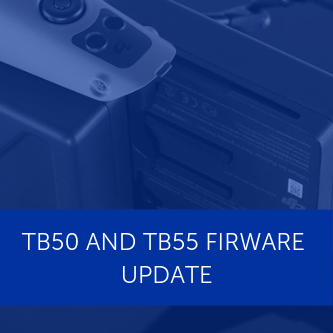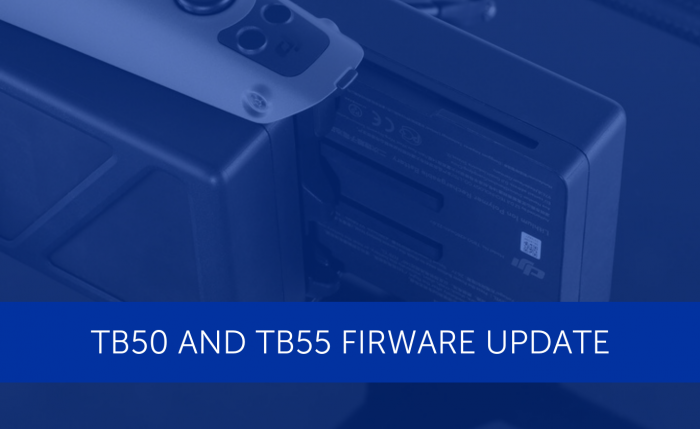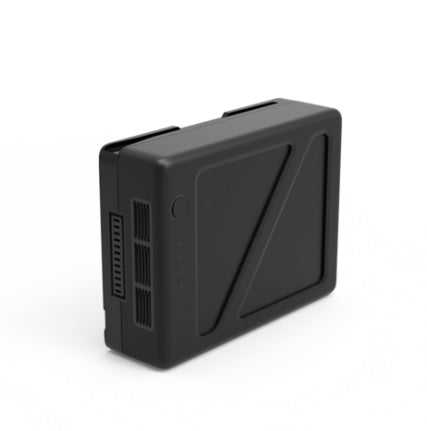
Updated on • 18 Aug 2024
DJI issues further TB50 and TB55 firmware updates
DJI releases new firmware updates for users of TB50 and TB55 batteries, addressing issues with some Matrice 200 Series drones. ... Read More

DJI has released new firmware updates for users of TB50 and TB55 batteries which address the small number of reports of Matrice 200 Series drones experiencing early Return-to-Home (RTH) or Automatic Landing (AL).
These cases are not due to product performance issues, but are false alarms triggered by conservative measures DJI implemented last month to prevent any further potential of M200 series drones experiencing loss of power mid-flight.

A TB55 battery
DJI continues a thorough investigation of the root cause of the issue until it is fully resolved.
DJI says that this new firmware update (v01.02.0301) further improves the algorithm accuracy of the battery-management system to enhance user experience without compromising flight safety and product reliability, which are DJI’s 'top priorities'.
The update is not mandatory, but M200 series drone operators are strongly advised to allow extra time before their next flight to update their drone and batteries to this latest firmware to minimise disruption to their operations.
DJI STATEMENT
TB55 BATTERIES
For TB55 batteries used with M200 series drones, the firmware update will impose these new battery safeguards:
Additional battery heating before take-off
The additional heating will prevent batteries from turning off unexpectedly at low temperatures.
The temperature of both batteries must now be 16°C (61°F) or higher before the aircraft can take off. This is because a battery with low temperature has a higher internal resistance, which causes lower voltage than in warmer conditions.
A battery with low voltage will provide a lower level of power to the drone, and hence impose higher risk of a power loss.
Please note that flight times vary depending on age of batteries, temperature of the environment, altitude or payload.
Improved battery percentage and fault detection
The battery percentage check before take-off has been improved and users will be warned when the battery is faulty or the remaining battery charge suddenly jumps to a false higher percentage.
The voltage of the battery will be used to verify the SOC value by the further improved DJI algorithm in the new firmware.
This SOC value will be compared to the one calculated by the battery SOC calculation algorithm to determine if there is a 'false high' SOC reading. If there is a 'false high' SOC reading, then the aircraft will not be able to take off.
Enhanced Return-to-Home (RTH) or Automatic Landing (AL)
When the DJI algorithm detects a difference in SOC levels (this calculation runs within the battery and is therefore not visible to users through the screen) between the algorithm and the actual level that is too large, RTH will be activated at a detected battery level of 30% and AL activated at 10% (based on the DJI algorithm).
Previously observed false alarms, that triggered early RTH or AL in a small number of cases, have been reduced drastically.
TB50 BATTERIES
For TB50 batteries used with M200 series drones, the firmware update will impose this new battery safeguard:

Additional battery heating before take-off
The additional heating will prevent batteries from turning off unexpectedly at low temperatures.
The temperature of both batteries must be 16°C (61°F) or higher before the aircraft can take off. This is because a battery with low temperature has a higher internal resistance, which causes lower voltage than in warmer conditions.
A battery with low voltage will provide a lower level of power to the drone, and hence impose higher risk of a power loss.
Flight times vary depending on age of batteries, temperature of the environment, altitude or payload.
Be aware of locking your drone
Pilots who are using drones of both the DJI M200 series and the DJI Inspire 2 with TB50 batteries may continue to receive an 'inconsistent firmware' notification when using batteries updated with different firmware versions. This may lock the drone.
DJI advises that pilots use batteries upgraded with the same firmware until a new firmware update is released in January.
After further testing and simulations, DJI decided not to issue a scheduled temporary firmware update for the Inspire 2 this month as there is no indication of flight safety being compromised.
Using batteries upgraded with the same firmware will solve this compatibility issue, in addition to improving overall user experience.
As with all Lithium batteries, there are several factors that impact the usability of your TB50 and TB55 batteries, including external variables such as weather and altitude where your flight takes place, as well as factors in your control such as storage and handling methods.
Tips for drone users
Make sure that the batteries are fully charged before use.
Preheat the battery at room temperature so that it reaches 16°C (61°F) (battery temperature can be monitored in the DJI Pilot /DJI GO /DJI GO 4 Apps).
If the environment is too cold, hover the aircraft for about 1 minute so the batteries can heat up to around 16°C (61°F).
Keep battery packs warm by:a) Hand warmers.b) Warm rice is recommended since it stays warm for long periods of time and is reusable: microwave about 5-10lb of dry rice in a large resealable bag. Heat for 5-10 minutes or until hot. Then place in a high-quality cooler with the batteries.c) Keep the batteries close to your body to use your body heat to keep them warm.d) Preheat the batteries while travelling so that they can be used immediately when arriving on site.
Remember that flight times will be reduced when operating in cold environments.
Make sure there is sufficient battery capacity to allow for a Return-to-Home. This also applies to the remote controller as it could power down during the flight if battery levels are not monitored.
Do not fly any partially discharged packs or packs that have entered self-discharge mode state.
When removing the aircraft from a warm environment to the cold, please let it acclimatise without batteries for at least 10 – 15 minutes.
When moving the RC from warm to cold you could receive a calibration error. If this happens, please turn off the aircraft and perform an RC calibration via the RC tab in the app.
Make sure to bring dry towels and wipe off any moisture that might build up during flight or in the field.
Please make sure all contacts on cameras and batteries are dry before installing or putting them in storage.
Smart gloves are not a requirement, but a recommendation. Smart gloves allow the use of a smart device without the need of removing the glove.
Do not store charged packs at temperatures lower than 0°C.
Never store batteries outdoors in cold temperatures. Doing so can seriously damage the packs or shorten their life dramatically. Batteries should be stored in a temperature between 10 - 45°C (50 - 113°F).
Always keep packs between 50 - 65% during storage. If stored for more than a few months, it is recommended to check these storage levels regularly. It is recommended that packs in storage be charged once every 90 days and then return them to a storage percentage of 50 - 65%.
#advgb-tabs-024e7896-d2fb-4afb-a364-aac520bebd67 li.advgb-tab.ui-tabs-active { background-color: #64bd2d !important; }
In the rare case that a pilot experiences early trigger of RTH or AL:
When a drone starts Smart RTH, pilots can interrupt and stop RTH by pressing the X on the screen.
When a drone begins AL, pilots can still steer the drone using the joystick to help find the safest landing location. Pushing up the throttle can also slow or counteract the descending aircraft.
It is important to note that these responses are not caused by any hardware fault. In the rare case that early RTH or AL is triggered, it is due to the risk mitigation strategy programmed into DJI's flight controller.
Battery taking a longer time to heat up:
This is caused by S1. DJI suggests pilots pre-heat their batteries or keep them at room temperature (about 16°C/61°F) before flying outdoors to minimise the risk of flight disruption.
Please read DJI's Intelligent Flight Battery Safety Guidelines and follow its updated user guidelines to help minimise potential disruption to your operations.
If you believe you may have experienced a related power problem involving the TB50 or TB55 battery, please contact DJI customer service at dji.com/support to report the issue.
BACKGROUND
In October, there were reports that a small number of TB50 and TB55 batteries had shown incorrect power levels, leading to loss of power mid-flight. Customers were urged to fly with caution when using TB50 and TB55 batteries in drones. DJI said it was working round the clock to find a solution.
At the time, the CAA released an initial safety notice, to highlight the requirement for the SUA operator and/or remote pilot to be reasonably satisfied that flights could be safely made, restrict overflight of people at any height, to temporarily limit the scope of certain operational authorisations issued to operators of the affected SUA, and to provide updated information regarding battery management requirements while the affected SUA were airborne.
Last month, DJI issued firmware updates for users of TB50 and TB55 batteries, to enhance the battery-management system and optimise power supply during flight.
In the wake of this, the CAA updated the safety notice to lift restrictions for operators and pilots of the affected drones who can confirm that the firmware updates have been successfully installed.
Now, the Chinese-based technology giant has issued its latest firmware updates.

written by
James Willoughby
James joined heliguy™ in 2018 following a 13-year stint in print and online journalism, having worked on regional and weekly newspaper titles. He is responsible for spearheading heliguy™'s content strategy and social media delivery. James collaborates with DJI Enterprise's European marketing team to coordinate and produce case studies and helps organise events and webinars.